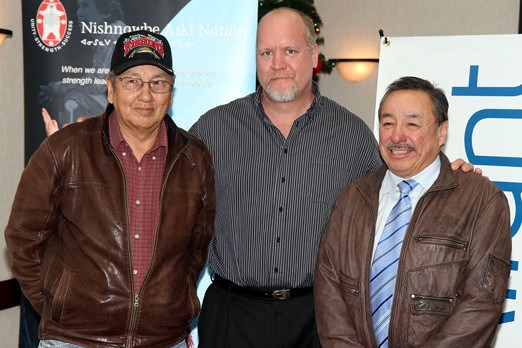Nishnawbe Aski Nation’s Grand Chief says that while First Nations people may have missed out on the industrial revolution, today’s technology is not going to pass them by.
More than 400 kilometres of a planned 2,470 kilometres of fibre optic cables has been laid in Ontario’s North, the ultimate goal to connect 25 remote Aboriginal communities to the world of high-speed Internet.
“If my people get left behind with technological advancements this time around, we’ll be left behind altogether,” Grand Chief Stan Beardy said on Monday, providing an update on the progress of the $81-million Northwestern Ontario broadband expansion initiative announced more than a year ago.
“The chiefs are making every effort to try to get our people to the starting point, to make sure that the tools to work with are out there. The infrastructure has to be there for the young people to have access to the technology.”
A modern society centres its business around the Internet, Beardy continued, noting there are plenty of other areas where access to the world wide web is integral, including health care and education, where the remoteness of many of the communities affected by the lack of broadband is truly felt.
“I think once they have access to high-speed Internet access, it opens doors for them to unlimited opportunity, in terms of education, online higher learning, e-commerce, e-health and everything else,” he said.
“I think it’s very exciting because for a long time we were isolated. We were out there by ourselves. With technology and high-speed Internet, it just creates more opportunities.”
Muskrat Dam Chief Gordon Beardy, who helped co-ordinate the project with Bell Aliant, said chiefs in the communities have realized for years he importance of a northern fibre optic network. But the trick was finding a company willing to make the investment.
He added the relationship will the company is a longstanding one, but one that has grown since the fibre optics decision was made, employing local workers and recognizing the importance of high-speed Internet to the quality of life in First Nations communities.
They knew it wasn’t going to be easy, and it hasn’t been. But they’ve persevered, Gordon Beardy said.
“It looked like we had a lot of issues to deal with, but we’ve overcome them,” he said.
Chris Bell, the general manager for Bell Aliant in Northern Ontario, said they knew what the obstacles were going to be, though some were unexpected.
Forest fires that forced the evacuation of several communities also meant workers were put on hold for up to six weeks, further delaying the project.
“Even something as simple as bird nesting season slowed us down by a few weeks,” he said.
There was no question in the company’s mind the project was worth the investment.
“We definitely have a vested interest in the area because we provide voice telecommunications up there today, via satellite or digital radio. It’s very old technology – I would call it sunset technology – and we need to do something over the next five to 10 years anyway. This gives us a good opportunity with some help from some funding partners, to put in the right solution,” Bell said.
The Northwestern Ontario broadband expansion initiative is a joint effort between NAN, the provincial and federal governments and Bell Aliant.
The next stage of development will see fibre optic cable laid between Red Lake and Poplar Hill, Ignace to Musselwhite mine and toward Cat Lake. The entirety of the project is expected to be completed by 2014.
